Discovering The Ice Giants: NASA’s Missions To Uranus And Neptune

Image of Uranus (left) and Neptune (right) provided by Astronomy magazine
May 3, 2021
One of the greatest achievements in mankind was successfully walking on the moon. Although this was accomplished almost 50 years ago, the underlying goal remains present in the twenty-first century: to push the limits of technology and to reach further into the universe. Recently, scientists have been pushing these limits once again by exploring the two most distant planets in our solar system, Uranus and Neptune.
In general, scientists don’t know much about these “ice giants.” Our only investigation was conducted in the late 1980s, and it was done using the twin spacecraft Voyager 1 and 2. Their initial mission was to circle Jupiter and Saturn for five years, but the spacecraft exceeded expectations. The Voyagers were capable of more exploration, so NASA scientists thought it would be best to go further into space and look at Uranus and Neptune.
Ipswich student Egan Davidson talks about how the Voyager spacecraft provided information involving “how big each planet is and how far they are from the sun.” According to NASA’s data from the Voyager Planetary Mission, both planets are around 31,000 miles in diameter, which is around four times larger than Earth. Furthermore, Uranus is roughly 1.8 billion miles from the sun, while Neptune is around 2.8 billion miles. To put this into perspective, Earth is just 93 million miles from the sun. These planets are large, dark, and cold.
In addition, the missions gave us images of the quantity and shape of the moons of the two plants. Voyager 1 and 2 discovered 10 moons surrounding Uranus with the surfaces scattered with craters, canyons, and two new rings around it. The spacecraft also found that Neptune had erupting geysers on its surface.
Due to technological advances, there are plans to send a new probe to investigate Uranus and Neptune. Amy Orroth, who is knowledgeable in this subject, describes how one of the main problems with long-distance probe missions is that it “takes some time to send [them] to different places, and [she’s] sure it takes a few years for the probes to reach Uranus and Neptune.” NASA’s new Space Launch System, their most powerful rocket, could eliminate that problem. Astrophysics Paul Sutter states that “a mission could reach Jupiter in a little less than two years from that speed boost. From there, a single spacecraft could separate into two components, one headed for Uranus (reaching it in 2042) and another for Neptune (achieving orbit a couple of years after that).”
Another technological hurdle is the communication systems. “For long trips, like ones to Uranus and Neptune, it’s hard to send frequency waves from the probe and back to Earth,” Egan Davidson adds. According to recent research, the frequency waves need to be at least 100 times stronger than the Cassini Mission to Saturn, which launched back in 1997.
Scientists and physicians are currently working on an improved communication technology to address this problem. For example, physicists are designing the Laser Interferometer Space Antenna (LISA), which can be used in space probes to detect and measure gravitational waves. This technology can also be used to transmit signals between the probe itself and back to Earth on long-distance missions.
These newly designed probes can detect an entirely different class of events, such as the merging of black holes and supermassive black holes, which we could never observe using previous gravitational wave detectors. But most importantly, these new probes allow us to properly explore Uranus and Neptune and further learn about these planets.
